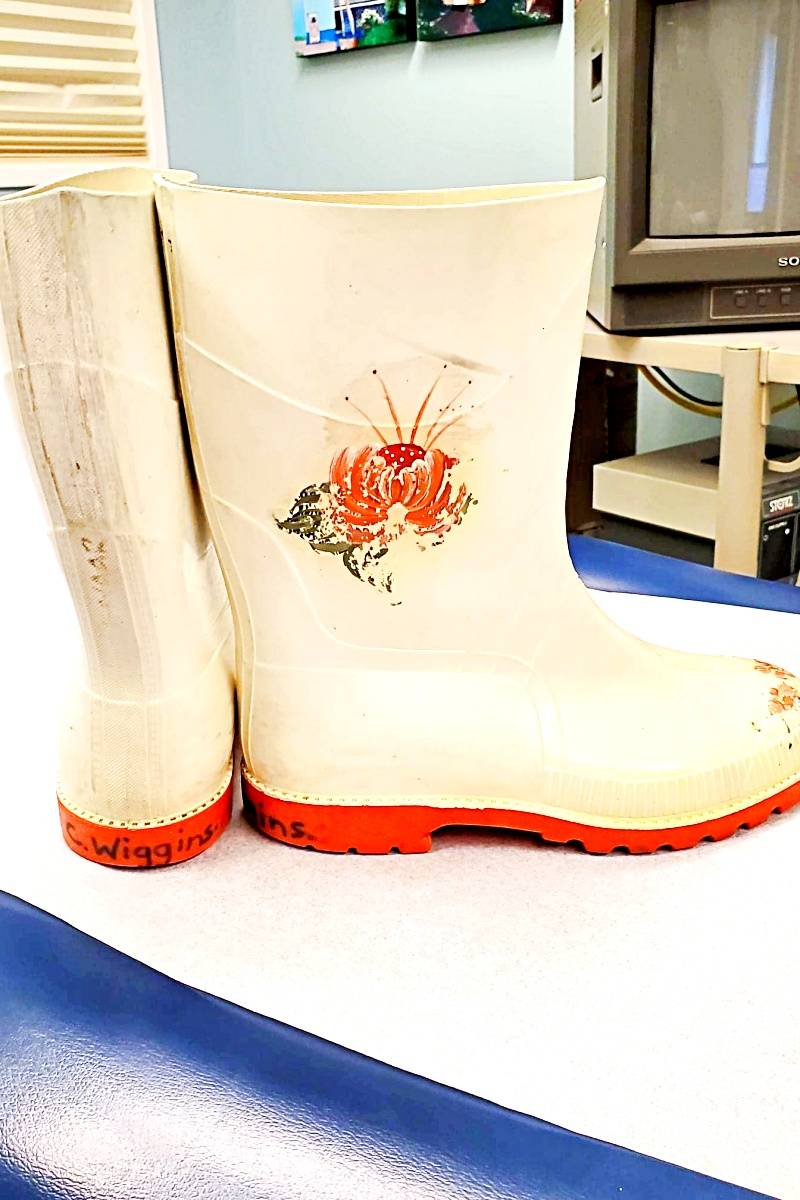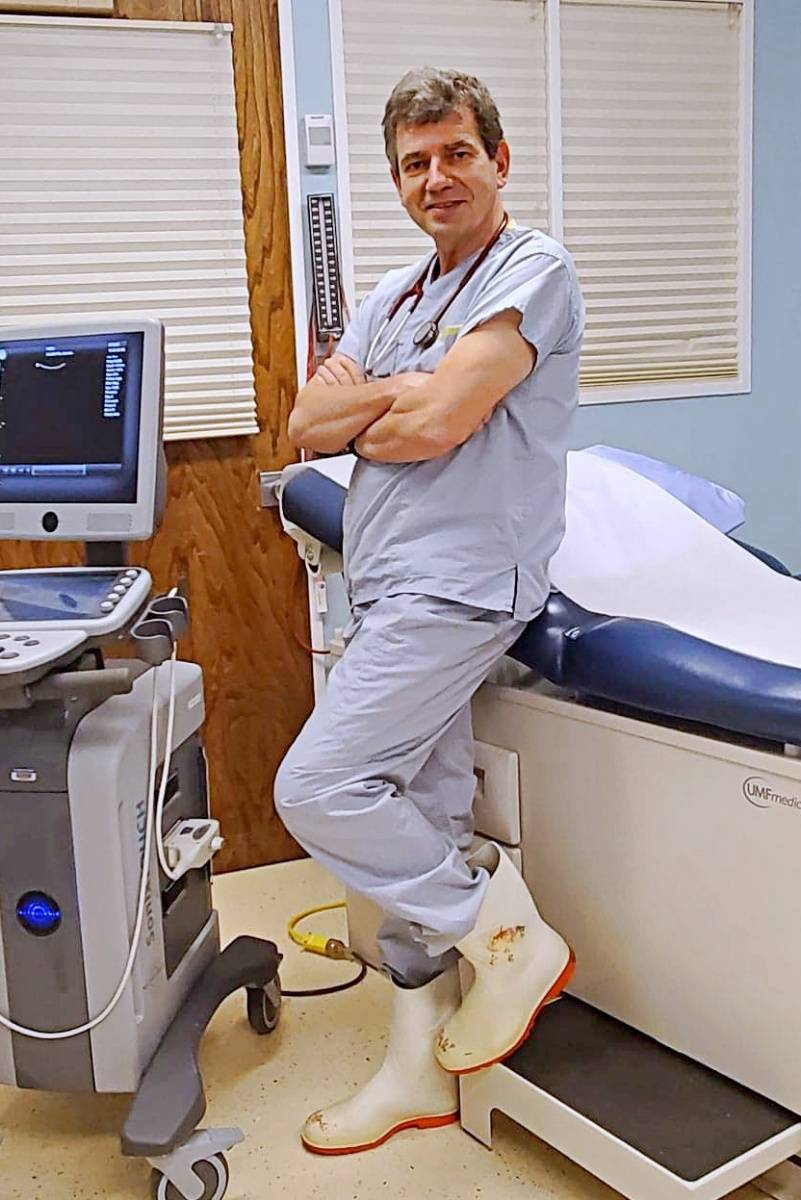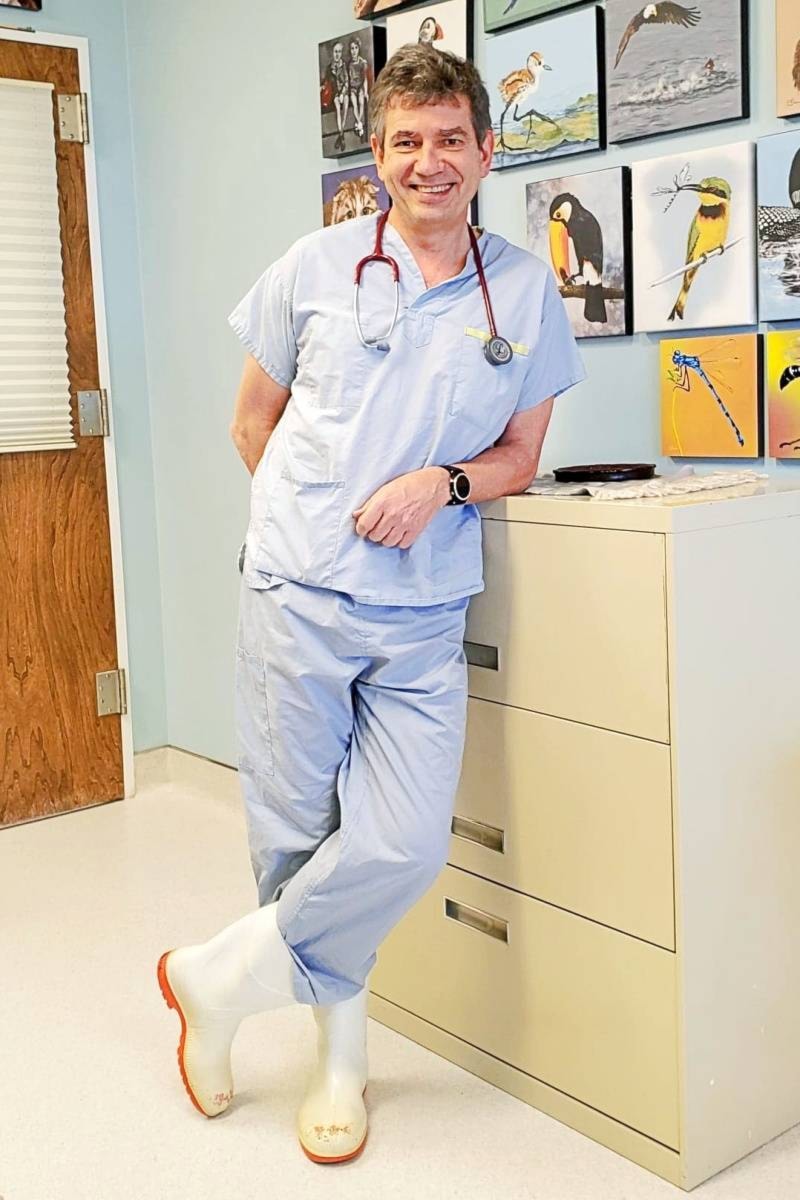It was the push of a button and the love of snow that transported Dr. Marius Pienaar to Prince Rupert from a hot South African climate to the rainforested region of B.C.’s north coast, more than 30 years ago.
After the Feb. announcement that he was hanging up his stethoscope on May 31, The Northern View caught up with the story-filled OBGYN to hear how the city captivated his heart and gave birth to a lifelong career as one of the region’s most known medical professionals.
The decision to move to a country with snow was made when Marius was in his early twenties just a year or two into his career, he said. Having lived all his life in South Africa he had never seen with his own eyes or touched with his own hands the coolness of snow.
“I had saved up all my little bit of savings when a friend of mine said he’s going skiing in Switzerland and invited me along. I went to Switzerland and on my very first day, I fell in love with skiing and snow. It was then I decided for the rest of my life I have to live in a country where there’s snow.”
“I knew immediately that there was this place called Canada where it snowed 24 hours every day throughout the whole year across the whole country, and that there are these guys in red uniforms. That’s about it. And they speak English.”
Marius arranged for a one-month locum position as a general practitioner to come to the snow-covered country.
“I flew in very excited because this is going to keep my skiing going. I got off the plane and looked around. It was then I realized ‘Oh my God, I’ve been screwed there. There are no mountains. I will not be skiing this year,” he said laughing at his misfortune.
It was the mid-1980’s and pre-internet, he said. No one had told him about Manitoba or Saskatchewan before he accepted the position in Saskatoon. It was the farmers he said, who educated him and told him he really needed to be on the west coast in British Columbia to be skiing.
Dr. Pienaar said the real treat to him was when they loaned him a car, gave him a week off, and sent him on his way to Banff.
“It was there and then I decided I am coming back to Canada. But you know, it wasn’t just the skiing,” he said.
Travel had open his eyes and coming from across the world in a time where different cultures were not as easily accessed, his trip had already taught him an important lesson that can only be learned by first-hand experience.
“You realize Canadians are not Americans. In fact, if you actually tell them that ‘you guys are Americans. You sound like them, you drive the same cars, you watch the same movies,’ well, they get angry at you,” he said. “I discovered, they were not. They were kind and gentle and I fell in love with Canada there and then.”
Marius returned to Cape Town to finish the last few years of his training with plans brewing in his mind on how to return to British Columbia. He said as there was no worldwide web so he pulled out his old high school map and put dots on every town and wrote letters to every hospital offering his services as a gynecologist.
“Three months later my response was zero. I thought ‘oh my gosh what am I going to do. How do I get a job in British Columbia’.”
He continued on with his life in South Africa working in a large twelve-floor training hospital when he was on his way to the gynecology department carrying charts and objects in his arms one day. He then pushed the elevator button that changed his life, he said.
Without looking up he exited the elevator when it stopped. The doors closed behind him. When he looked up he realized he was on the wrong floor. His eyes fell on a poster about a presentation to the pediatricians by a Canadian doctor.
He attended the presentation and afterward stopped to speak to the doctor who he thought was a child specialist. It turns out Pienaar said, that he was an OBGYN. The doctor was leaving his practice in the following year. He was from a small town in British Columbia called Prince Rupert.
“I took over from him, and it was a match made in heaven. I immediately fell in love with this little town.”
Pienaar considers himself very fortunate to have his feet firmly standing in Prince Rupert and said it has been a good fit for him. The right match is going to be needed to fill his boots.
“ I can say that the 10 years before I came, there had been 11 different gynecologists. That’s a big turnover …” the doctor said. “And certainly for my replacement, I’m hoping we can find that match — somebody that not only can provide the broad spectrum of skills, but also loves the town. You know, it’s a rare combination to find that and hopefully, we can nail the right person.”
When asked how many babies he’s delivered here on the North Coast in his more than three decades, he said he doesn’t know, probably in the thousands.
“I have no idea how many babies I delivered. I really don’t know why everybody focuses on the babies because I think I’ve delivered more uteruses than babies,” he said. There’s a (heck) of a lot of other stuff we do.”
“This practice area is the broadest practice of any practice in B.C. I would say that we do everything. Absolutely everything. Babies are just one small part of it. In fact, so much so that most of the time when I’m involved with deliveries, it’s when something goes wrong. The GP’s do all the normal deliveries. Only if there is a disaster, they call me and I jump in and try to save the day.”
Saving the day requires filling some big boots after assisting so many women and families throughout his career. Pienaar’s boots are almost as well known as he is.
Pienaar said his white surgical boots have run him through many births and operating procedures starting from his training days in that Cape Town hospital where the elevator ride brought him to a new life.
The hospital had a footwear budget and encouraged the doctors to order boots.
“The whole idea is if there’s any blood or amniotic fluid it all falls on the boots and not on your shoes,” the doctor said.
So, as a young trainee he took advantage of the budget and order his regular size. When the boots arrived they were “massive”, he said. Coming from overseas the boots were sized differently. The stores-clerk told him there were no others —he ordered them so he was stuck with what he got. However, he was told there was a pair that had been lightly worn by another doctor who had left them behind after a transfer out.
Pienaar found boots that fit.
“I wore them for five years during my training in South Africa. Then I brought them here and I have worn them now for 29 years with every delivery,” he said.
The boots have had a life of their own and have been the topic of operating room conversation many times. Once about 28 years ago they appeared to walk away on their own.
“I was asking around who stole my boots, who stole my boots? They were plain old white gumboots,” Pienaar said.
“Then two weeks later, the boots showed up with these painted flowers on and they just remained there. The pink flowers have remained on the boots ever since,” he said. “It was a nurse. She stole my boots. It was a maternity nurse, and I still remember her name.”
But the story continues Pienaar said, jumping forward to 1995 in Prince Rupert.
“We recruited this general surgeon, from South Africa. His name was Chris Wiggins. I never knew him. He came from a different medical school at a different place in the country.”
“Maybe two or three weeks after he was here, he looked at me and he says, ‘What are you doing with my boots on?” Pienaar asked him what he meant.
“There on the heel of the boots was his name written,” Pienaar said. Dr. Wiggins was the original owner of the boots left at the Cape Town training hospital before moving out of South Africa to start a medical position.
“He did two weeks in our training hospital, got a pair of boots, went back to his home after a two-week rotation, and left those boots. He finished his training in a different specialty, in a different hospital,” Pienaar said. “He comes to a small rural town, on the other side of the world, literally, physically on the other side of the world. And there’s somebody wearing his boots.”
“These boots are special because they have that story. For me, it’s ‘wow, what are the odds of that?’ Thank God, they already had pink flowers on them, so he didn’t want them back. I got to wear those boots for the rest of the 29 years of my career.”
K-J Millar | Journalist
Send K-J email
Like the The Northern View on Facebook
Follow us on Twitter


